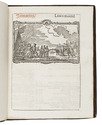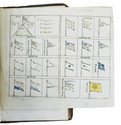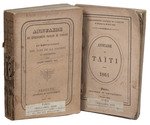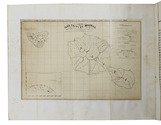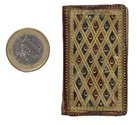Unrecorded 1712 almanac in an elaborately gold-tooled binding with a silver pin fastening, by the Amsterdam Art Book Bindery



DAM, Jan Albertsz. van.
Nieuw geinventeerde koopmans comptoir- en schrijf-almanach, op het schrikkel-jaar onzes heeren J. Christi M DCC XII. Na de nieuwe styl. Versien met de jaarmarkten, paarde- beeste- en leer-markte, en de dageliksche uure van de maans op en ondergang.
Amsterdam, the heirs of Albert Magnus, [1711 (for the year 1712)]. 12mo. Printed in red and black throught, the title-page with Magnus's woodcut device (Atlas with an armillary sphere on his shoulders), numerous typographical symbols in the text: for example a horse and a goat representing horse and other animal market days, moons in different phases, planetary signs and manicules (pointing hands). With a small etching of an angel (39 mm tall) holding a wreath, cut out of an unidentified source and loosely inserted between 2 blank pages at the end of the book. Contemporary, elaborately gold-tooled mottled calf over thin wooden boards by the so-called Art Book Bindery (1705-1741) in the style made famous by Albert Magnus himself, with more than 100 impressions of about a dozen stamps and one roll, gold-tooled board edges. Further with 4 silver anchor plates (2 on each board), each with the coat of arms of the States of Holland in a decorative cartouche, and each with a silver eye extending over the fore edge, with a silver combination stylus/lead pencil used to fasten the book through the eyes, gilt edges. [120] pp. bound with 46 blank free endleaves: [12] pp. at the front and [22 (coated paper)], [12] pp. at the back. Full description
€ 7,500
Amsterdam, the heirs of Albert Magnus, [1711 (for the year 1712)]. 12mo. Printed in red and black throught, the title-page with Magnus's woodcut device (Atlas with an armillary sphere on his shoulders), numerous typographical symbols in the text: for example a horse and a goat representing horse and other animal market days, moons in different phases, planetary signs and manicules (pointing hands). With a small etching of an angel (39 mm tall) holding a wreath, cut out of an unidentified source and loosely inserted between 2 blank pages at the end of the book. Contemporary, elaborately gold-tooled mottled calf over thin wooden boards by the so-called Art Book Bindery (1705-1741) in the style made famous by Albert Magnus himself, with more than 100 impressions of about a dozen stamps and one roll, gold-tooled board edges. Further with 4 silver anchor plates (2 on each board), each with the coat of arms of the States of Holland in a decorative cartouche, and each with a silver eye extending over the fore edge, with a silver combination stylus/lead pencil used to fasten the book through the eyes, gilt edges. [120] pp. bound with 46 blank free endleaves: [12] pp. at the front and [22 (coated paper)], [12] pp. at the back. Full description



